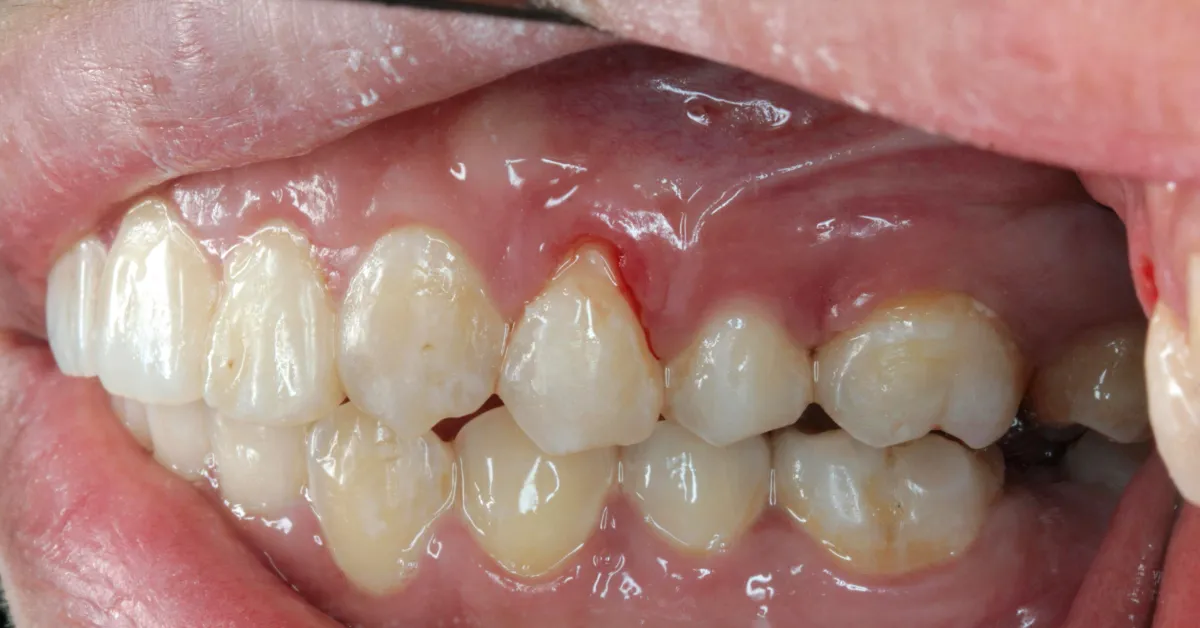What is Gum Recession?
Gum recession, also known as gingival recession, occurs when the gum tissue surrounding the teeth pulls back or wears away, exposing more of the tooth or its root. This condition can lead to various oral health issues, including increased sensitivity, root decay, and, in severe cases, tooth loss. Gum recession is a common dental concern, affecting people of all ages, but it becomes more prevalent with age.
Other Names for Gum Recession
Aside from “gingival recession,” gum recession may also be referred to as “receding gums” or “gingival attachment loss.” These terms all refer to the same process of gum tissue pulling away from the tooth, exposing its root surface.
Standard Definition of Gum Recession
In dental terms, gum recession is defined as the apical (downward) migration of the gingival margin (gumline) away from the crown of the tooth, which can lead to the exposure of the tooth root. This condition often results from a combination of factors, including aggressive brushing, gum disease, or even genetics.
Types of Gum Recession
Gum recession can be classified into two primary categories:
1. Physiological (Non-Pathological) Recession: This type of gum recession occurs as a normal part of aging or due to anatomical factors. In physiological recession, the gums recede gradually and are typically not accompanied by inflammation or other signs of disease.
2. Pathological Recession: Pathological gum recession is caused by factors such as poor oral hygiene, gum disease, or trauma to the gums. This type of recession is often accompanied by inflammation, discomfort, and other symptoms that may indicate an underlying dental issue.
Normal vs. Abnormal Gum Recession
• Normal (Physiological) Gum Recession: Mild gum recession is considered normal with age, as gums naturally wear and pull back slightly. This type of recession is usually slow and does not cause significant symptoms or tooth sensitivity.
• Abnormal (Pathological) Gum Recession: Abnormal gum recession, on the other hand, is associated with symptoms like bleeding, swelling, pain, and exposed tooth roots. It may be caused by conditions like periodontitis (advanced gum disease), improper brushing techniques, or the use of tobacco products.
Features and Signs of Gum Recession: When to Look Out
The symptoms of gum recession can vary depending on the cause and severity. Some common features to look out for include:
• Exposed Tooth Roots: When the gum tissue recedes, more of the tooth’s surface or root becomes visible.
• Increased Tooth Sensitivity: Exposed roots can cause sensitivity to hot, cold, and sweet foods and beverages.
• Changes in Gum Appearance: The gums may appear thinner or more uneven, with gaps forming between the gumline and teeth.
• Bleeding Gums: In cases of pathological recession, gums may bleed, especially during brushing or flossing.
• Loose Teeth: Severe gum recession, often due to advanced gum disease, can lead to tooth mobility.
If you notice any of these signs, it’s essential to consult a dental professional to determine the cause and receive appropriate treatment.
Precautions to Avoid Gum Recession
To prevent or reduce the risk of gum recession, consider these precautionary steps:
1. Use a Soft-Bristled Toothbrush: Choose a soft-bristled toothbrush and brush gently to avoid damaging gum tissue. Avoid hard-bristled brushes, which can wear away the gums over time.
2. Practice Proper Brushing Technique: Brush at a 45-degree angle, gently massaging the gums rather than scrubbing. Avoid aggressive back-and-forth motions, which can contribute to gum recession.
3. Floss Regularly: Flossing helps remove plaque and food particles between the teeth, reducing the risk of gum disease—a leading cause of gum recession.
4. Avoid Tobacco Products: Smoking and other tobacco use increase the risk of gum disease and recession by affecting blood flow and oral health.
5. Regular Dental Checkups: Schedule regular dental cleanings and checkups. Early detection of gum issues can prevent recession from progressing.
6. Wear a Mouthguard if Needed: If you grind or clench your teeth (bruxism), wearing a mouthguard can help protect your teeth and gums from damage that might lead to recession.
7. Address Misaligned Teeth: Misaligned teeth can put uneven pressure on the gums, contributing to recession. Orthodontic treatments like braces can help reduce this risk.
Conclusion
Gum recession is a common dental issue that can have lasting impacts on oral health if left untreated. Recognizing the signs of gum recession and understanding its causes, types, and risks can help you take preventive action and maintain healthy gums. Regular dental care, proper oral hygiene, and a gentle approach to brushing can go a long way in protecting your gums from recession. If you notice any signs of receding gums, consult your dentist for evaluation and guidance on the best steps for treatment and prevention.









